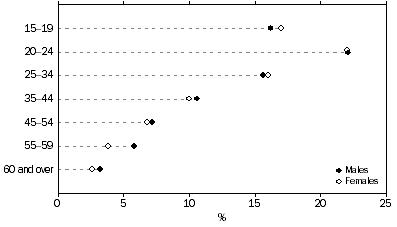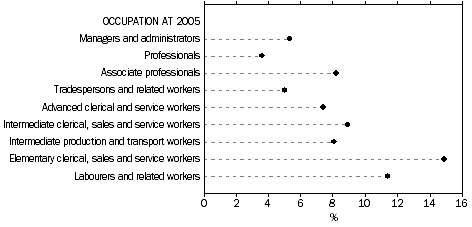REASON FOR RE-ISSUE OF PUBLICATION
Errors were detected in the publication, Labour Mobility, Australia (cat. no. 6209.0), which was reissued 12 December 2006. This publication has since been reviewed and the following is a summary of the changes contained in this most recent reissue:
- Data have been revised in Table 10 because incorrect data were presented for Whether changed industry (February 2005 and February 2006), for the population Persons who worked at some time during the year ending February 2006, and had been with their current employer/business for less than 12 months at February 2006.
These revisions will be reflected in all future products from the 2006 Labour Mobility Survey.
NOTES
ABOUT THIS PUBLICATION
This publication presents information about people aged 15 years and over who worked at some time during the year ending February 2006.
The statistics in this publication were compiled from the Labour Mobility survey, conducted throughout Australia in February 2006 as a supplement to the Australian Bureau of Statistics (ABS) monthly Labour Force Survey (LFS).
This survey provides information about people who, within the 12 months to February 2006, either had a change of employer/business in their main job, or had some change in work with their current employer/business for whom they had worked for one year or more.
NOTES ABOUT THE ESTIMATES
The scope of the Labour Mobility survey was expanded in February 2006 to include all people aged 15 years and over. All results in this publication relate to all people aged 15 years and over, unless otherwise specified. This change has resulted in an extra 73,300 people coming within the scope of this survey. Users need to exercise care when comparing the estimates in this publication with previous releases.
New data items have been introduced into the 2006 survey to provide information on people who had worked with their current employer/business for one year or more, and had changes in the work undertaken with their current employer/business in the last 12 months. These data items include whether promoted or transferred, whether changed usual hours worked and whether changed occupation.
Data items that referred to locality, which were included in previous Labour Mobility publications, are not presented in this publication as the information was not collected in the February 2006 survey.
ROUNDING
As estimates have been rounded, discrepancies may occur between sums of the component items and totals.
INQUIRIES
For further information about these and related statistics, contact the National Information and Referral Service on 1300 135 070 or Labour Market Section on Canberra (02) 6252 7206.
CONCEPTUAL FRAMEWORK
LABOUR MOBILITY
The following diagram illustrates the conceptual framework for the 2006 Labour Mobility survey. People aged 15 years and over were classified according to the duration of their employment with their employer/business at February 2006.
People who had worked with their employer/business at February 2006 for one year or more were asked whether, in the 12 months to February 2006, they had changed the number of usual hours worked. Employees (excluding owner managers of incorporated enterprises)¹ were also asked whether they had been promoted, transferred to a different position, or changed occupation in the 12 months to February 2006. Employees who reported any of these changes were considered to have had some change in work2 in the 12 months to February 2006.
END NOTES
1. Refer to the Glossary under 'Employment type'.
2. Either promoted, transferred to a different position, changed usual hours worked or changed occupation. Refer to the Glossary for the definition of 'Change in work'.
SUMMARY OF FINDINGS
OVERVIEW
An estimated 10.8 million people aged 15 years and over had worked at some time during the year ending February 2006. At February 2006, 73% had been with their current employer/business for one year or more, 20% had been with their current employer/business for less than 12 months and 8% were not employed.
CHANGE OF EMPLOYER/BUSINESS
Of the 9.9 million people aged 15 years and over who were working at February 2006, 11.6% had changed their employer/business in their main job in the last 12 months.
Of the 1.2 million people who had changed employer/business in their main job in the 12 months to February 2006:
- 24% had two or more changes of employer/business
- 55% changed industry
- 44% changed occupation
- 75% changed usual hours worked
- 37% changed employment type¹.
PERSONS WHO WERE WORKING AT FEBRUARY 2006, Proportion who changed employer/business in the last 12 months - By age groups

Of the people who were working at February 2006, those in younger age groups tended to change their employer/business more than people in older age groups. For example, of the 20-24 year olds who were working at February 2006, 22% had changed their employer/business. This compares to 4.9% of those aged 55-59 and 3% of those aged 60 years and over.
COMPARISONS WITH PREVIOUS SURVEYS
Prior to 2006 the scope of the Labour Mobility survey was restricted to people aged 15 to 69 years so direct comparisons between 2006 and previous years can only be made using this common population.
Of the 9.9 million people who were working at February 2006 and aged 15-69 years, 11.7% had changed their employer/business in their main job in the 12 months to February 2006, which was similar to previous years (11.3% in February 2004 and 11.5% in February 2002).
The percentage of people aged 15 to 69 years who had been working with their current employer/business for less than 12 months increased from 19.9% in 2002 to 20.1% in 2004 and 21.4% in 2006.
CHANGE IN WORK
There were 6 million employees, excluding owner managers of incorporated enterprises (OMIEs)1, who had been with their current employer for one year or more. Of these, in the last 12 months:
- 5.8% had changed occupation
- 13% had changed usual hours worked
- 12% were promoted
- 11% had transferred to a different position.
There were 1.6 million employees (excluding OMIEs) who had been with their current employer for one year or more and had some change in work² in the 12 months to February 2006. Of these, at February 2006:
- 29% were aged between 25-34 years
- 22% had a Bachelor Degree
- 25% were Professionals
- 15% were working in the Retail trade industry.
EMPLOYEES(a) WHO HAD BEEN WITH THEIR CURRENT EMPLOYER/BUSINESS FOR 12 MONTHS OR MORE, Proportion who had some change in work² in the last 12 months - By age groups

Of employees (excluding OMIEs)1 who had been with their employer at February 2006 for one year or more, those in the 25-34 year age group were most likely to have had some change in work² in the last 12 months (30% of men and 38% of women). Across all age groups, the proportion of females who had some change in work2 was higher than their male counterparts.
WORKING AT FEBRUARY 2005 AND 2006
There were 9 million people who were working at February 2005 and February 2006. Of these:
- 89% had the same employer/business at February 2005 and February 2006
- 11% had a different employer/business at February 2005 and February 2006.
PERSONS WHO WERE WORKING AT FEBRUARY 2005 AND AT FEBRUARY 2006, Proportion who had a different occupation at February 2005 and February 2006

Of those people who were working at February 2005 and February 2006, people who were Elementary clerical, sales and service workers at February 2005 were most likely to have a different occupation at February 2006 (15%) followed by Labourers and related workers (11%); whereas Tradespersons and related workers (5%) and Professionals (3.6%) were least likely.
Of the 120,700 Elementary clerical, sales and service workers who had a different occupation at February 2005 and February 2006, 39% became Intermediate clerical, sales and service workers, and 15% Associate professionals.
DURATION WITH EMPLOYER/BUSINESS AT FEBRUARY 2006
In February 2006 there were 2.1 million people who were currently working, and had been with their current employer/business for less than 12 months. Of these:
- 55% had a previous employer/business in their main job in the 12 months to February 2006
- a higher proportion of men than women had changed their employment type¹ (23% compared to 18%).
The industry groups in which the highest proportions of people had worked with their employer/business at February 2006 for less than 12 months were:
- Accommodation, cafes and restaurants (38%)
- Retail trade (28%)
- Mining (28%)
- Communication services (26%).
There were 2.5 million people who were working at February 2006 and had been with their current employer/business for 10 years or more. A greater proportion of men than women had been with their current employer/business for 10 years or more (28% compared with 22%). The industry groups in which people were most likely to have worked for 10 years or more were Agriculture, forestry and fishing (51%), Electricity, gas and water supply (42%), Education (38%) and Government administration and defence (35%).
PERSONS WHO CEASED A JOB DURING THE LAST 12 MONTHS
Of the 10.8 million people who had worked at some time during the year ending February 2006, 19% had ceased a job. Of these, 68% were job leavers (people who ceased their last job voluntarily) and 32% were job losers (people who ceased their last job involuntarily). Of the 641,700 job losers, 59% had been in that job for less than 12 months, and a further 12% had worked in that job for between one and two years. The remaining 29% had worked in that job for two years or more. The main reason for ceasing a job involuntarily was 'Job was temporary or seasonal' (50%).
END NOTES
1. Refer to the Glossary under 'Employment type'.
2. Refer to the Glossary for the definition of 'Change in work'.
 Print Page
Print Page
 Print All
Print All